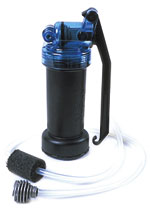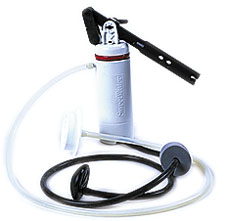![]() January-February 2001
January-February 2001
By Karen Berger
Photographs by John R. Fulton Jr.
You're halfway up the mountain, it's getting hot, and your group is slowing down. Someone is thirsty. Someone else is hungry. As luck would have it, the perfect snack spot presents itself—a few trees for shade, some perfectly shaped sitting rocks, and a sparkling mountain stream. As you reach down to fill your canteen, you can already taste the clear, cold water.
 The MiniWorks filter ($65, MSR) has a ceramic element with an inner carbon core. Its flow rate is 1 liter per 90 seconds. |
Wait! Stop! Not so fast!
Time was, you could just dip and sip. No more: The sad truth is most backcountry water is no longer safe to drink.
Blame it on pesticides, fertilizers, or chemicals from old mines. Blame it on the innocent-looking marmot who just stopped to do his daily business on a patch of snow melting into a trickle of water. Or blame it on your fellow hikers, whose not-always-environmentally-sound camping practices pollute the very water they depend on.
Regardless of the cause, the fact remains: A "clear" mountain stream can harbor all kinds of pollutants, bacteria, and protozoa that you don't want to meet up close and personal. The best known is Giardia lamblia, a waterborne protozoan that spends part of its life cycle in mammalian intestines and can make humans violently ill. Other microscopic ne'er-do-wells include Cryptosporidium, which causes giardia-like symptoms, and bacteria such as E. coli and Salmonella.
On a short day-hike, you may be able to carry enough tap water that you don't have to worry about what might be lurking in a stream. But on a longer hike or a backpacking trek, you'll need to refill those bottles—and that means treating your water, no matter how clear and refreshing it looks.
 The Orinoco Personal Water Purification System ($40, Exstream) removes viruses as well as waterborne cysts and protozoa. |
There are three basic strategies for doing this—boiling, treating with chemicals, and filtration.
Boiling is the tried-and-true method of killing all those microscopic cooties. But boiling has limitations, especially for a group.
It takes a lot of fuel and time to boil and let cool enough water to keep a group of Scouts happily hydrated. And water boiled over a fire tastes of smoke.
Some guidebooks, outdoor organizations, and land management agencies suggest boiling water for 5 to 10 minutes. However, the Wilderness Medical Society and others say you need only bring water to a boil (with half-inch bubbles rising to the surface) to make sure everything is completely dead, even at high altitudes.
Chemical treatments. Lightweight, reliable, and hassle-free, iodine is a longtime hiker favorite and, according to the Centers for Disease Control and Prevention (CDC), is more effective in a wider variety of circumstances than chlorine, whose effectiveness depends on conditions that are hard to control in the backcountry, including water temperature, organic content of the water, and pH. But there are a few drawbacks:
 The Swiss-made Combi ($159, Katadyn) can filter 200 liters of water before it is necessary to replace the unit's activated carbon. |
Water filters work by straining out parasites and pollutants. The measure of a filter is its "absolute pore size." This means that nothing bigger can squeeze through. Most serious backcountry filters have absolute pore sizes of one micron or less, which will block the cysts of both Giardia and Cryptosporidium.
Filter pore sizes are not, however, small enough to remove viruses; for that, you need a water purifier, which attacks tiny viruses chemically. Several filters do both jobs: They first remove larger cysts and bacteria by straining, and then they kill viruses with small doses of iodine. Environmental Protection Agency (EPA) standards for water purifiers are tough; purifiers must remove 99.9 percent of cysts, 99.99 percent of viruses—and 99.9999 percent of bacteria.
It's debatable whether backcountry users need a filter that removes viruses. For many years, common wilderness wisdom was that viruses were more likely to be a problem in less-developed countries than in the United States. But according to Christopher Voxland, vice president and general manager of Exstream Water Technologies, more than 181,000 people contracted the Norwalk virus from surface water last year in the United States.
"It's a relatively mild virus," says Voxland, "but it still gives you a week of discomfort. You're most at risk if you're camping in a national park or a popular area that attracts people who are beginning backcountry users. They may not know about minimum impact guidelines for disposing of human waste, like camping 200 feet from rivers and springs and burying waste six inches deep."
Voxland regards a purifier as an insurance policy. "I don't buy car insurance because I expect to get in a wreck," he says. "I buy it in case the unexpected happens."
 The Guardian ($50, SweetWater) filters a liter of water per minute and includes a bottle cap adapter for hands-free filling. |
No question, filtering water is a chore: The daily pumping required to keep 8 or 10 campers well watered can be daunting. A few tips can make it easier:
Karen Berger writes about hiking and backpacking for http://www.gorp.com, an online resource for outdoor recreation. She is also the author of five books, including Hiking and Backpacking: A Complete Guide (W. W. Norton & Co.).
Copyright © 2001 by the Boy Scouts of America. All rights thereunder reserved; anything appearing in Scouting magazine or on its Web site may not be reprinted either wholly or in part without written permission. Because of freedom given authors, opinions may not reflect official concurrence.
| The Boy Scouts of America | http://www.scouting.org |